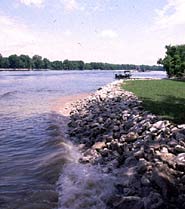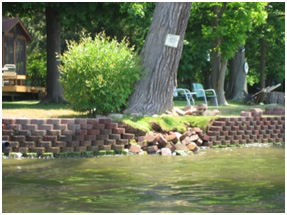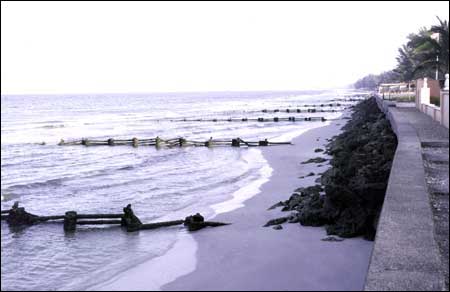Erosion Control and
Shoreline Management
There are two main generators for shoreline erosion. Waves and construction. This section will talk about how to protect the shoreline from erosion due to waves. General erosion issues are covered under other sections. But since construction is a large generator of erosion, the county strictly enforces the Soil Erosion and Sedimentation Control Law which requires a permit for any earth change within 500 feet of a lake or stream.
The ideal erosion-resistant shoreline is an undisturbed, naturally vegetated, gradually sloping, rock-filled beach. Waves break at significant distance from shore where most of their energy is expended in the surf zone before ever reaching a sturdy, rocky beach made even more durable by the root systems of native plants. To best preserve the shoreline environment, stabilization methods should follow these basic principles:
- Imitate nature -The native vegetation usually found at the shoreline strengthens its structural integrity and prevents the land from breaking apart. The deep roots of these plants bind the earth together while their foliage and branches protect from the erosion caused by rainfall and winds. Removing these plants can cause the shore to weaken and easily crumble into the water.
- Keep slopes gentle – The gradual slope of a natural shoreline absorbs the energy of waves. A steep, eroded slope or retaining wall allows waves to crash into the shore, drastically increasing erosion and causing that wave energy to cause damage on adjacent shorelines.
- Employ “soft armoring” whenever possible – By “soft armoring” we refer to live plants, logs, root wads, vegetative mats, and other methods that eliminate or reduce the need for “hard armoring”, such as rock rip-rap, stone blocks, sheet-pile or other hard materials. Soft armor is alive and so can adapt to changes in its environment as well as reproduce and multiply. It also provides habitat for fish and wildlife. Vegetation can be kept trimmed so as not to block the view – after all, that’s why many of us choose to live near the water!
- Mix it up – Regardless of the type of natural shoreline encountered, you will undoubtedly see a wide diversity of materials: live trees, dead branches, stumps, rocks of many shapes and sizes, silt, sand, cattails, grasses, flowering plants, etc. By imitating this variety, you can maintain or reproduce the natural value of the shoreline and have an effective, resilient, and eye-pleasing shoreline. Working with these natural and locally available materials can also dramatically cut project costs. In the end, a mix of techniques may yield the best project, uniquely fit for your situation. If your area is already developed, it is a good idea to look to nearby undeveloped shoreline areas for examples of a more natural state.
- Keep it small and simple – In some instances, only a portion of your shoreline area may be eroding. If this is the case, a small or mixed rip-rap and vegetation project may suffice. Keep in mind that healthy trees are often the cornerstones of a stable shoreline.
Next to natural vegetation, the most promising and lake-friendly method of erosion control is the rock revetment. These carefully layered and sloping structures are intended to be built parallel to the shoreline and, when properly designed, are capable of stabilizing the shoreline while absorbing wave energy and not reflecting it elsewhere to adjacent beach areas. Ideal design characteristics, such as the mix of rock sizes, their placement, incline of slope, overall dimensions, and choice of materials are beyond the scope of this website. Consideration for aesthetics strongly suggests that rounded, naturally occurring fieldstone is far preferable to broken chunks of used concrete.
Revetment structures such as the rip-rap design shown have been developed from observation of natural shoreline areas whe re rock and gravel deposits have produced stable protective erosion barriers that conform to local township ordinances and Michigan Department of Environmental Quality (MDEQ) requirements. Property owners can call MSU Extension, Benzie County, 231-882-0025, for additional information on revetments.
re rock and gravel deposits have produced stable protective erosion barriers that conform to local township ordinances and Michigan Department of Environmental Quality (MDEQ) requirements. Property owners can call MSU Extension, Benzie County, 231-882-0025, for additional information on revetments.
Harmful Shoreline Alterations
The last line of defense against erosion is the bulkhead or retaining wall. Bulkheads should be considered only where there is an abrupt and significant rise from the water to the dry land. The disadvantages of bulkheads and retaining walls are several: shoreline habitat is degraded; bulkheads are not esthetically attractive; Retaining walls cause waves to crash into the shore. Much of the energy of these waves is reflected, causing bottom scouring and erosion beyond the end points of the bulkhead. The dirt or “substrate” is slowly dug out from under the wall’s foundation, eventually causing it to lean and then tumble into the water. Being the rigid structures that they are, bulkheads usually succumb to the perpetual forces of nature over time, their useful lives ending in eventual massive failure due to ice or a storm event.
into the water. Being the rigid structures that they are, bulkheads usually succumb to the perpetual forces of nature over time, their useful lives ending in eventual massive failure due to ice or a storm event.
Retaining walls are often installed after natural shrubs and trees have been removed, and thereby indirectly increase the nutrient load in the lake. The more seawalls around a lake, the more quickly the lake’s water quality deteriorates. Also, the wave action against a seawall generates a turbulence that loosens sediment, clods the water and frees up nutrients. When seawalls replace overhanging vegetation and shore plants in the shallows, the immature fry of game fish species and baitfish have nowhere to hide and feed and eventually, the native reproduction of fish will diminish.

A “groin” is a structure that is perpendicular to the shoreline and extends from shore out into the water. Typically constructed of rocks, groins do not inherently protect beaches from erosion. Migrating sand may accumulate on the upwind side only if there are prevailing winds and there is an upwind supply of beach material from a neighbor’s beach. If accumulated sand does drift around the outer end of the groin, some of the sand is likely to be lost in deep water, never to return to the beach. The MDEQ has indicated that rarely, if ever, are permits granted to construct groins as part of an erosion-control project.
Anyone contemplating a shoreline erosion control project should review the erosion-control guidebook, Understanding, Living With and Controlling Shoreline Erosion, prepared under the sponsorship of the Tip of the Mitt Watershed Council. Personal copies can be obtained from the Tip of the Mitt Watershed Council by phoning 231/347-1181. Permit applications can be obtained from the Land and Water Management Division of the MDEQ by phoning 517/373-9244. The Land and Water Management Division of the MDEQ regulates all activities on “bottom lands,” including those just listed, by issuing permits. “Bottom land” is defined in the Natural Resources and Environmental Protection Act (1994 PA 451) to mean, “the land area of an inland lake or stream that lies below the ordinary high-water mark and that may or may not be covered by water.” The MDEQ web site on Shoreline Protection offers a wealth of information as well as an indexed presentation of the Natural Resources and Environmental Protection Act (1994 PA 451).
